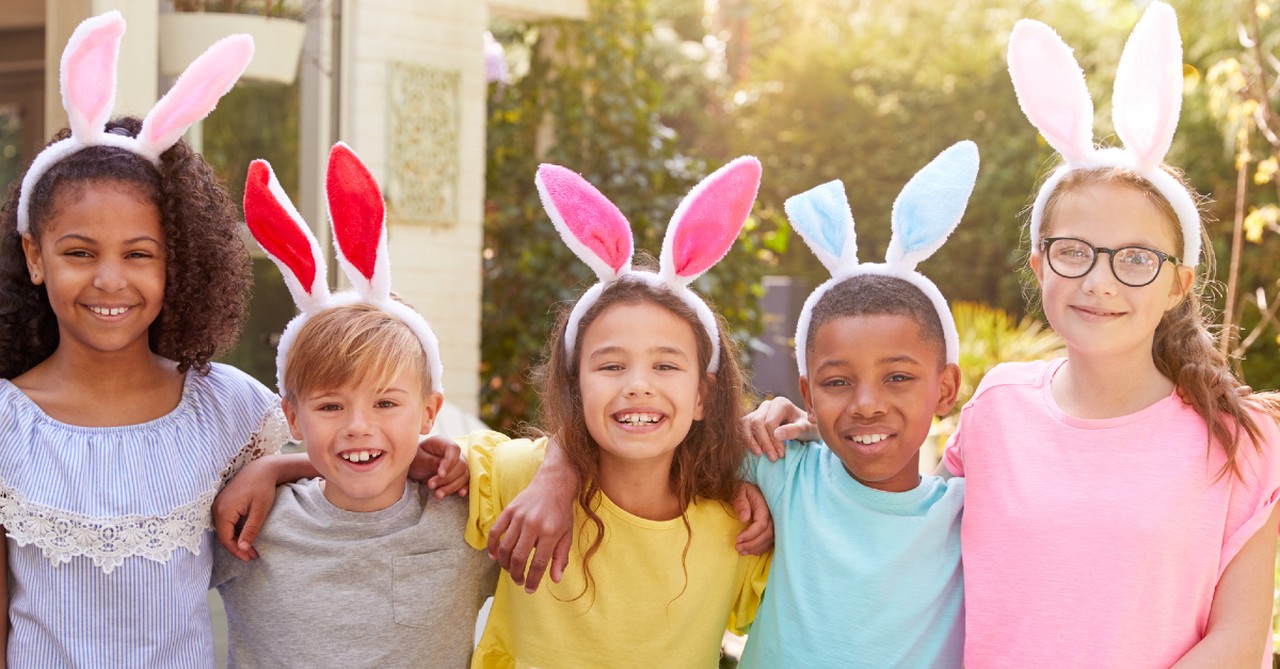7 Creative Ways to Teach Kids the Meaning of Easter

Easter fills children’s minds with visions of eggs filled with jellybeans and bunnies made of chocolate. As parents, we want out children to understand and celebrate the real treasures of Easter, the gifts of forgiveness and eternal life.
Set a goal for what you want your children to learn this year and consider ways to make that happen. Make it fun as you journey toward Easter.
Photo Credit: ©GettyImages/monkeybusinessimages
1. Choose the Main Message(s) to Teach

1. Choose the Main Message(s) to Teach
SLIDE 1 OF 7
Consider what you most want your child to know about Easter.
Your child may be young or sensitive and details about the crucifixion may be too much to share. That’s okay. They can learn a little more each year as they mature.
Start with the hope of Easter. Jesus came so we could live with Him in heaven when our time on earth is done.
Young children are not likely to understand the complexity of sin, sacrifice, or holiness—but they can easily absorb that Jesus loves us.
Consider what points to discuss and when. You might want to tackle one a day.
- Share how and why Easter happened.
- Chat about how people are not perfect and sin, so we all need forgiveness.
- Discuss what it means to sacrifice. Share how Jesus chose to sacrifice for us. He made a big sacrifice because he died for us.
- You can also share about a different sacrifice from long ago called the Passover that God used to free the Israelites from slavery.
- Let your child know that Jesus did more than die. He came back to life! He opened the gates of heaven. The sacrifice of the cross frees everyone who believes in Jesus.
Once you decide the main focus for this Easter, choose what activities will help you reach your goal.
Make sure you set aside time to carry out any ideas. Discuss activities done at meals and ask your children to share lessons learned. The feedback will help you know if the message has been clear.
Photo Credit: ©Unsplash/Matt
2. Make Easter Learning an Adventure

2. Make Easter Learning an Adventure
SLIDE 2 OF 7
Make the days and/or weeks before Easter an adventure of journey of discovery. Teaching about Easter begins with Lent and what happened before Easter. Talk about ashes and sin.
Share how Adam and Eve sinned and God’s words that we came from and return to ashes in Genesis 3:19: “By the sweat of your brow, you will eat your food, until you return to the ground, since from it you were taken, for dust you are and to dust you will return.”
Chat about people giving up things during lent, such as giving up desserts and giving money saved to the poor. Or giving up watching a favorite show to spend the time praying for people in need.
This is a type of sacrifice because it’s giving up something we like. It’s also about doing something for someone else
Prepare to celebrate the joy of Easter and new life. Spend time outdoors looking at plants and flowers that died during winter and search for signs of new life.
Talk about how Jesus came to die on a cross so we could live. On Good Friday make a cross by tying two cinnamon sticks together with a red ribbon. The red is a reminder of Christ’s blood. Cinnamon smells sweet and reminds us that death was sweet because it gave us forgiveness and eternal life.
At Easter, talk about the joy of Jesus coming back to life. Rejoice over anything new such as new clothes, flowers, and smiles.
Praise God to rejoice that Jesus is alive.
Photo Credit: ©GettyImages/ijeab
3. Give Praise

3. Give Praise
SLIDE 3 OF 7
Share about praise and reasons to be happy for Easter.
One week before Easter many churches celebrate Palm Sunday when Jesus rode a donkey into Jerusalem. People waved palm branches and praised Jesus shouting, “Hosanna,” which means to save.
Have your own parade in your neighborhood with real branches or ones cut from paper. Wave the branches as you march to praise music and shout out reasons to praise Jesus.
Make a praise tree with green paper leaves. On each one write a note or word of praise. See if you can cover the tree with lots of praise.
Bring joy to family members too. Use an empty plastic egg for each family member and fill it with words on paper to show thanks and compliment the person. Thank God for each person.
Host a praise night where you sing your favorite worship songs as a family in your living room. Psalm 100:1 tells us to make a joyful noise to the Lord—God isn’t concerned with how good of singers we are.
On Easter Sunday use some empty eggs. Open each egg and yell out the tomb is empty! Jesus is Risen. He is Risen indeed? Or make resurrection rolls by rolling rough around a marshmallow and bake them. The insides will be empty.
Take an Easter walk and praise God for all creation and the beauty on earth. Praise God for heaven that you cannot see yet and how much more wonderful that will be to experience. Pause at any sign of new life to thank God for life now and eternal life to come.
Photo Credit: ©Unsplash/Anna Pritchard
4. Celebrate the Lord’s Supper

4. Celebrate the Lord’s Supper
SLIDE 4 OF 7
The night before Jesus died He celebrated the Passover and gave us a special gift we call communion. Some churches use the word Eucharist because it means thanks.
Jesus gave thanks over the bread and said “This is my body.” He shared it with the disciples. Read more about it in Matthew 26:26-29.
Check out other details of that supper. One person, Judas remained unhappy. He chose to betray Jesus. Look around and ask if any family member is unhappy and pray for the person. We want our hearts to be open to Jesus and that means being cleansed.
Pray for God to forgive each person and fill your hearts with love.
Jesus also washed the disciples’ feet at this time, which showed his great humility and love for his disciples. He talked about how we need to be cleansed. Wash one another’s feet.
Make it a spa time to massage them and add sweet-smelling creams. Discuss forgiveness. If your church holds a service for Hold Thursday, attend and then discuss what happened as a family.
After the meal, Jesus sang a hymn with his friends. He enjoyed their company. Listen to some hymns and discuss the words. Chat about how Psalms were written as songs.
Talk about favorite Christian songs and why you like them. Jesus and his friends walked to a grove of trees at the Mount of Olives. Take a family walk and share about how it’s important to be with loved ones.
Photo Credit: ©Unsplash/Priscilla du Preez
5. Investigate Passover

5. Investigate Passover
SLIDE 5 OF 7
You might be able to attend or hold your own Seder dinner that celebrates Passover. Read about Passover in Exodus 312:3-28 and Matthew 26:18-19.
If you have Jewish friends, ask them to share about Passover and what it means to them. Listen to answers when you ask what Passover foods they have and why.
Jesus and His friends made plans for the Passover (Matthew 26:17-19). They prepared for this time together. Take time to plan a seder meal or other special meal where you can share about Jesus.
The meal involves questions and answers as to why celebrate Passover as well as special foods that symbolize what happened.
There’s also three pieces of unleavened bread. The middle one is called the Afikomen. It is broken and hidden for children to find. Christians consider that piece to represent Christ whose bones were broken and who was buried.
The blood of the Passover lamb was put on the doorpost so God would pass over those houses so the angel of death would save the firstborn people in the homes.
God used it to deliver them. Jesus is called the new Passover lamb (1 Corinthians 5:7, John 1:36) because he delivered us.
They had spent many years as slaves and God used miracles to free them, including parting the Red Sea. They had prayed for God’s help and God answered.
Passover reminds us that God answers prayers to save people. Understanding the deep meaning and symbolism of Passover will help you and your children to appreciate its connections to the cross and Jesus’ sacrifice that much more.
Photo Credit: ©GettyImages/pushlama
6. Hold a Special Treasure Hunt

6. Hold a Special Treasure Hunt
SLIDE 6 OF 7
Make an individual treasure hunt for each child.
A treasure or Easter basket of goodies can be at the end of the hunt. Give each child the first clue and say, “This is a clue to follow. You can choose to do the hunt or not. Jesus gives you a choice too. You can choose to follow Him or not. But, if you follow Jesus you will have treasure in heaven. If you follow this clue you will find a treasure today.”
Have them read Matthew 6:19-21 to understand the amazing treasure we can have in heaven: “Do not store up for yourselves treasures on earth, where moths and vermin destroy, and where thieves break in and steal. But store up for yourselves treasures in heaven, where moths and vermin do not destroy, and where thieves do not break in and steal. For where your treasure is, there your heart will be also.”
For younger children who don’t read yet, print photos and cut them into jigsaw puzzles for clues.
For older children try different types of clues such as secret messages, scriptures, and riddles. If this becomes a tradition, older children may want to create clues for younger siblings.
If desired, have little gifts with each new clue. That adds excitement to the hunt and helps children continue when clues seem hard.
If they need a special decoder or idea how to solve a secret code, have it ready to handout. Or hand out an empty basket with the first clue so children can tuck in the little treasures found with each clue solved.
After the hunt talk about the fun of finding a treasure. Then discuss the joy of the treasure of eternal life.
Photo Credit: ©GettyImages/DGLimages
7. Fill Baskets with Symbols of Love

7. Fill Baskets with Symbols of Love
SLIDE 7 OF 7
Use an Easter basket to share God’s love. Find items that reflect the Easter story. You can add in eggs sold that share the Easter story or a book about Easter. Here are a few ideas to get your mind thinking about what to add to a basket that reflects God’s love at Easter.
- A rose or prickly as a reminder of the crown of thorns Jesus wore for us. A rose also reminds us of the bloodshed. There’s also beauty and fragrant scent that reminds us of the good that came from Jesus dying for us.
- A butterfly reflects new life and how we will be changed when we go to heaven. We will be perfect.
- Scriptures related to the death and resurrection for children to put in the correct order.
- Stickers with a message that Jesus wants us to stick close to Him.
- Use a chocolate lamb or cross as a reminder that the sweetest gift of all is what Jesus did for us.
- Fish crackers or fishing game/gear as reminders that Jesus calls us to be fishers of men.
- Add in packets of seeds. Gardens and trees are part of the Easter story. Plant the seeds and watch them grow. Chat about how our minds and faith grow.
- Include something white as a reminder that the disciples found the white clothes that had been wrapped around the body of Jesus. When Jesus rose his clothes were as white as snow.
As you take Easter photos, record messages from your children. Ask each child to share what makes Easter special and what he or she learned this year. That creates a spiritual Easter memory to save for years to come.
Karen Whiting writes to helps families thrive. Her latest family devotional 52 Weekly Devotions for Families Called to Serve helps develop servant hearts in children.
Photo Credit: ©Pexels/NickyPe
Karen Whiting is a mom, author, international speaker, writing coach, and former television host who loves sharing ideas to strengthen families. She has written Growing a Mother’s Heart: Devotions of Faith, Hope, and Love from Mothers Past, Present, and Future and 52 Weekly Devotions for Family Prayer, which includes a different way to pray each week plus stories and activities to explore questions children ask about prayer. Her book, Growing a Joyful Heart co-authored with Pam Farrel, shares stories that show how to have inner joy, more joy in relationships, choose joy in all circumstances, and become a joy-giver. Her latest book is Stories of Faith and Courage from the Home Front, written with Jocelyn Green. She loves adventure including camel riding, scuba diving, treetop courses, and white water rafting plus time at home crafting and baking.
Originally published March 14, 2023.









